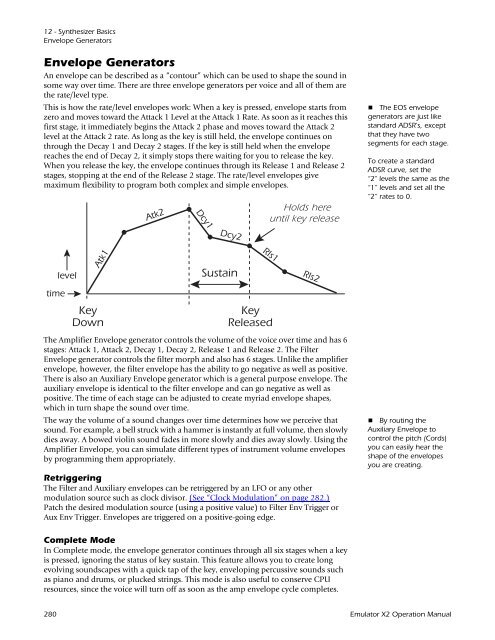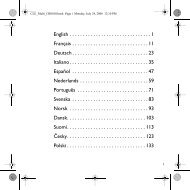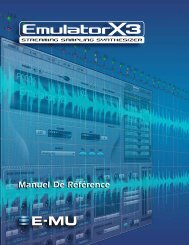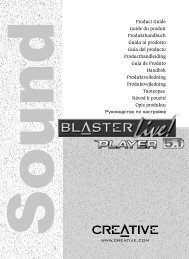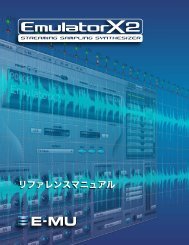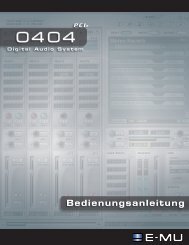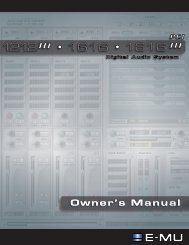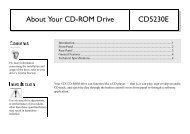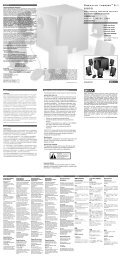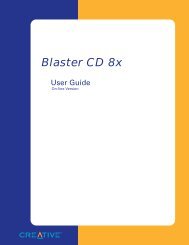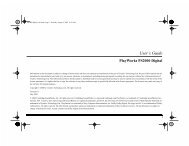Emulator Composite.book - Creative
Emulator Composite.book - Creative
Emulator Composite.book - Creative
Create successful ePaper yourself
Turn your PDF publications into a flip-book with our unique Google optimized e-Paper software.
12 - Synthesizer Basics<br />
Envelope Generators<br />
Envelope Generators<br />
An envelope can be described as a “contour” which can be used to shape the sound in<br />
some way over time. There are three envelope generators per voice and all of them are<br />
the rate/level type.<br />
This is how the rate/level envelopes work: When a key is pressed, envelope starts from<br />
zero and moves toward the Attack 1 Level at the Attack 1 Rate. As soon as it reaches this<br />
first stage, it immediately begins the Attack 2 phase and moves toward the Attack 2<br />
level at the Attack 2 rate. As long as the key is still held, the envelope continues on<br />
through the Decay 1 and Decay 2 stages. If the key is still held when the envelope<br />
reaches the end of Decay 2, it simply stops there waiting for you to release the key.<br />
When you release the key, the envelope continues through its Release 1 and Release 2<br />
stages, stopping at the end of the Release 2 stage. The rate/level envelopes give<br />
maximum flexibility to program both complex and simple envelopes.<br />
time<br />
level<br />
Atk1<br />
Key<br />
Down<br />
Atk2<br />
The Amplifier Envelope generator controls the volume of the voice over time and has 6<br />
stages: Attack 1, Attack 2, Decay 1, Decay 2, Release 1 and Release 2. The Filter<br />
Envelope generator controls the filter morph and also has 6 stages. Unlike the amplifier<br />
envelope, however, the filter envelope has the ability to go negative as well as positive.<br />
There is also an Auxiliary Envelope generator which is a general purpose envelope. The<br />
auxiliary envelope is identical to the filter envelope and can go negative as well as<br />
positive. The time of each stage can be adjusted to create myriad envelope shapes,<br />
which in turn shape the sound over time.<br />
The way the volume of a sound changes over time determines how we perceive that<br />
sound. For example, a bell struck with a hammer is instantly at full volume, then slowly<br />
dies away. A bowed violin sound fades in more slowly and dies away slowly. Using the<br />
Amplifier Envelope, you can simulate different types of instrument volume envelopes<br />
by programming them appropriately.<br />
Retriggering<br />
The Filter and Auxiliary envelopes can be retriggered by an LFO or any other<br />
modulation source such as clock divisor. (See “Clock Modulation” on page 282.)<br />
Patch the desired modulation source (using a positive value) to Filter Env Trigger or<br />
Aux Env Trigger. Envelopes are triggered on a positive-going edge.<br />
Dcy1<br />
Dcy2<br />
Sustain<br />
Complete Mode<br />
In Complete mode, the envelope generator continues through all six stages when a key<br />
is pressed, ignoring the status of key sustain. This feature allows you to create long<br />
evolving soundscapes with a quick tap of the key, enveloping percussive sounds such<br />
as piano and drums, or plucked strings. This mode is also useful to conserve CPU<br />
resources, since the voice will turn off as soon as the amp envelope cycle completes.<br />
The EOS envelope<br />
generators are just like<br />
standard ADSR’s, except<br />
that they have two<br />
segments for each stage.<br />
To create a standard<br />
ADSR curve, set the<br />
“2” levels the same as the<br />
“1” levels and set all the<br />
“2” rates to 0.<br />
By routing the<br />
Auxiliary Envelope to<br />
control the pitch (Cords)<br />
you can easily hear the<br />
shape of the envelopes<br />
you are creating.<br />
280 <strong>Emulator</strong> X2 Operation Manual<br />
Rls1<br />
Key<br />
Released<br />
Holds here<br />
until key release<br />
Rls2


